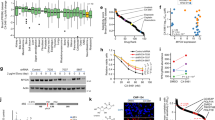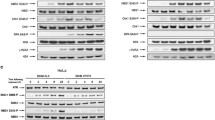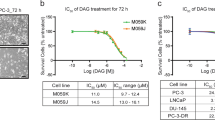Abstract
The catalytic cycle of topoisomerase II is the target of some of the most successful antitumor agents used today, e.g., etoposide (VP-16), in the treatment of testicular cancer and small-cell lung cancer. The cell kill mediated by topoisomerase II poisons can be antagonized by distinct drug types. Thus, we have demonstrated etoposide antagonism with the type-II anthracycline aclarubicin, the antimalarial drug chloroquine, and the cardioprotective agent ICRF-187. In other setups, combinations of agonist and antagonists have led to high-dose regimens for counteracting drug resistance. Thus, the exploitation of folinic acid rescue for methotrexate toxicity and the use of mesna to protect against cyclophosphamide toxicity have enabled the use of high-dose methotrexate and cyclophosphamide protocols. Using a similar approach, we have studied possible ways to apply antagonists to topoisomerase II poisons. NDF1-hybrid female mice were treated with the various drugs and drug combinations. Lethality (LD10 and LD50 values) was computed by use of the maximum-likelihood method, and the antitumor effect of the drugs was compared in mice inoculated i.p. with either L1210 cells or Ehrlich ascites tumor cells. In addition, the compounds were tested on L1210 cells inoculated intracranially. The toxicity of the various drugs was evaluated by weight and leukocyte counts. ICRF-187 rescues healthy mice from lethal doses of topoisomerase II poisons. In mice the ICRF-187 LD10 was 500 mg/kg. Within a wide nontoxic dose range (50–250 mg/kg) of ICRF-187 we found protection against m-AMSA and etoposide lethality. Thus, the LD10 of etoposide increased from 34 mg/kg for the single agent to 122 mg/kg for its combination with ICRF-187, corresponding to a 3.6-fold etoposide dose escalation. In contrast, ICRF-187 did not protect against lethal doses of the non-topoisomerase II-directed drug paclitaxel. We further investigated the antitumor effect of equitoxic schedules in mice inoculated i.p. with L1210 or Ehrlich ascites tumor cells. The L1210-bearing mice appeared to obtain a larger increase in life span from the etoposide and ICRF-187 combination as compared with etoposide alone, whereas this was not the case in mice inoculated with Ehrlich ascites tumor cells. As the hydrophilic ICRF-187 is not expected to cross the blood-brain barrier, in contrast to the lipophilic etoposide, we investigated the effect of the drug combination in mice inoculated intracranially with L1210 cells. We obtained a significant increase in life span in mice treated with ICRF-187 + etoposide as compared with mice treated with an equitoxic dose of etoposide alone. Thus, there appear to be potential routes by which one can benefit from this antagonism. ICRF-187 is a powerful nontoxic protector against the lethality of the topoisomerase II-directed drugs etoposide and m-AMSA in vivo. A brain tumor model demonstrates the superiority of high-dose etoposide treatment with ICRF-187 protection as compared with etoposide treatment alone. This implies that tumors in the brain can be reached by cytotoxic drug doses and that normal tissues can be protected due to differences in drug transport across the blood-brain barrier. ICRF-187 is therefore a promising lead compound for the development of schedules using high-dose topoisomerase II poisons in the treatment of brain tumors and metastases.
Similar content being viewed by others
Author information
Authors and Affiliations
Additional information
Received: 15 June 1995/Accepted: 16 November 1995
Rights and permissions
About this article
Cite this article
Holm, B., Jensen, P. & Sehested, M. ICRF-187 rescue in etoposide treatment in vivo. A model targeting high-dose topoisomerase II poisons to CNS tumors. Cancer Chemother Pharmacol 38, 203–209 (1996). https://doi.org/10.1007/s002800050472
Issue Date:
DOI: https://doi.org/10.1007/s002800050472




